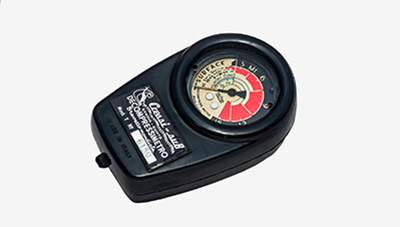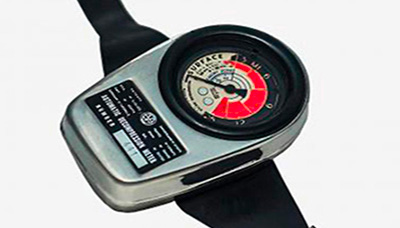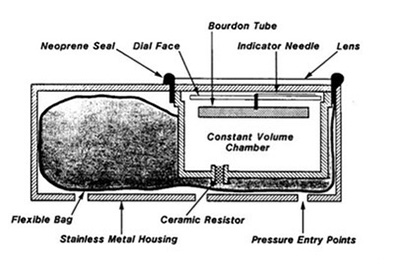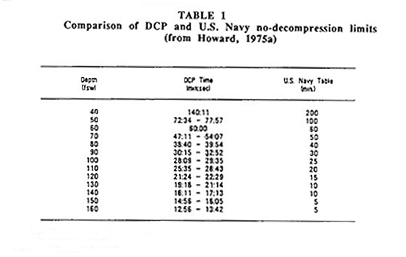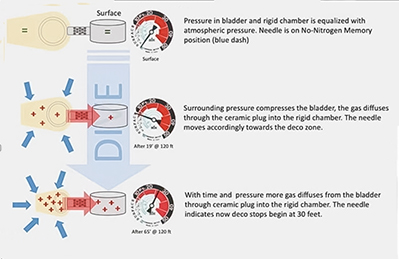1960 - DCP
In 1960, Eng. Carlo Alinari presented his decompression gauge to CMAS general meeting in Barcelona, the first analogical diving computer. It was developed in cooperation with Eng. Victor Aldo De Sanctis, a pioneer in the diving photo-video field, with whom, at the end of the ‘50s, founded in Turin the SOS–Strumenti Ottici Subacquei (Optical Diving Instruments) company. At the beginning, they introduced in the market the first depth gauges in oil bath and now, they were going to market the DCP, the only automatic instrument to calculate decompression, existing at that time.
|
|
|
| fig. 1a - Il DCP in plastica | fig. 1b - Il DCP in acciaio inox |
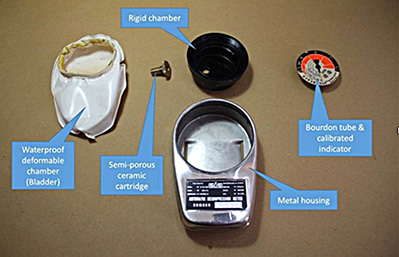 |
|
| fig. 2 - iIl DCP le parti componenti | fig. 3 - Il DCP schena di funzionamento |
Simple and reliable, it was technically based on a pneumatic principle which simulated saturation and desaturation of the 120- minute tissue compartment, indicating no-deco times or eventual decompression stops at 3-6-9-12-15 meters. DCP had a plastic case; it was produced until 1990, when it was substituted by more advanced digital computers.
Nowdays, its princinple may be considered primitive but, for that period of time, it was a real revolution; it became very popular among divers all over the world. Inevitably, the materisl used and some manufacturing imperfections caused a certain "variability" of the shown results, above all in case of repetitive dives; in some environments, it was called "Bend-O-Meter". “Bends” partially caused not to malfunctionings but to normal divers’ wrong habits or to the lack of a periodical check of its correct functioning, as we can see in this side box. Around 1975, the detailed conclusions of the United States Navy validated this project; according to them, DCP presented only a small deviation from the no-decompression limits compared to their tables.
|
|
|
| fig. 4 - le tabelle US Navy | fig. 5 - funionamento del DCP in discesa |
To understand this instrument’s functioning, which case became in stainless steel in 1964, we must imagine it in a diver’s wrist during his descend. The ambient pressure acting in its inside flexible bag increseases and, for the Boyle and Mariotte law, the excess air contained herein is forced into a small chamber with a constant volume, by the ceramic filter which simulates the human body’s nitrogen absorption and elimination. This pressure increase in the chamber with a constant volume determines a gauge of the Bourdon tube that, by a mechanism, indicates in the quadrant, moment by moment, the minimum depth to which diver could ascend in all safety. In reality, when the diver begins his ascend, for the same Boyle and Mariotte law it happens that the gas in the chamber with constant volume becomes greater than the external pressure; the gas flow inverts, provoking a contrary gauge of the Bourdon tube. The mechanism now indicates in the quadrant the effective minimum depth to which the diver must stop until the index dosn’t give the ok to surface or, to reach a lower deco stop. This decompression gauge, in its different versions and, thanks to the validity of this project was marketed also by several other known dive equipment companies, such as Beuchat, Spirosub, Dacor, CressiSub, Mares, Scubapro, Technisub and others.
1974 – THE “FOUR TISSUE” DECOMPRESSION GAUGE
Seen the big success of the DCP gauge, in 1974 SOS launched the DCM 4 decompression gauge with four tissues, a model based on the DCP principle that simulated the nitrogen absorption and release of four tissues instead of one. This device is composed of 4 modular elements, corresponding to the tissues with emisaturation times of 10-20-30-40 minutes.
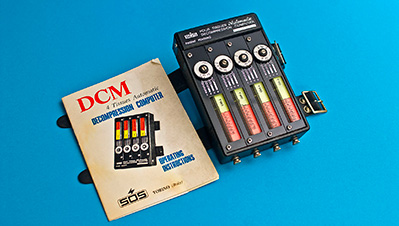 |
| fig. 6 - Il DCM 4 tessuti |
Each element has a setting button with which diver can insert specific values in the calculation, such as water temperature and dive interval. These elements are changeable with others, calibrated with different partial times, suitable for professional or particular demanding dives because of depth, duration, and type of activity. DCM 4 functioning is different of DCP since, in each modular element, hydrostatic pressure pushes a silicon fluid through a resistant element in a chamber closed by a piston, which moves contrasted by a spring. During ascent, diver halts at the first deco stop when the index of the conducting tissue enters into the red zone; when there is the ok to go, diver can proceed his ascent to stop at the next deeper depth among the four indicated by each element. When all indexes exit the red zone and enter into the yellow one, diver can ascend to the surface.
1975 - DCK GAUGE
In 1975, SOS launches another decompression gauge called DCK. Compared to the previous models, this new gauge had the advantage of having a better clear and readable display. In fact, diver could read decompression data based on a yellow line moving on a gray background against red stripes, which indicated the deep stops from 15 to 3 meters. As in previous models, its functioning was very simple; until the mobile element didn’t come out of the deeper deco stop sector, diver wasn’t allowed to ascend to the next deco stop; when the index left the red zone, diver could ascend to the surface. This was true for dives where bottom time mentioned as BT did not exceed 30 minutes; in case of longer dive times, diver could ascend to the surface when the yellow line left the stripes which indicated the bottom time (30 minutes - 1 hours or 1-2 hours). At the surface, DCK also showed residual nitrogen values in diver’s body for the follow-up decompression procedure. In fact, yellow line slowly descended towards left for a maximum of 6 hours along the so called "Memory Zone", recording the gradual elimination of residual nitrogen after last dive. After 12 hours, diver could consider himself completely desaturated.
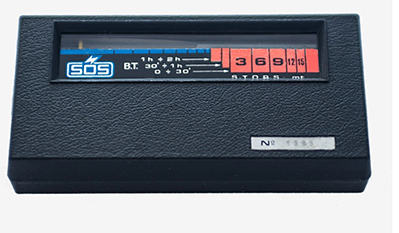 |
| fig. 7 |
This decompression gauge was evaluated as satisfactory and basically reliable for standard dives up to a depth of 60 meters; compared to other models, it could be carried in the airplane, without the need of an hermetic seal container.
One curiosity regarding DCK was the suggestion given by the manufacturer to the more experienced divers to largely reduce decompression times. The procedure consisted in progressively reducing the depth of deco stops by passing, for example, from 9 to 8 meters after that the index reached 2/3 of the 9-meter line; then, passing from 8 to 7 meters when the index was at 1/3, and so on. Divers who wanted a higher safety were not encouraged to follow this practice; the diver could ascend to the surface only at the end, when the index exited the red zone of the 3 meters.
1977/1979 – DCS and DCS+Dt2 GAUGES
Between 1977 and 1979, SOS launched in the international market a new series of products to calculate decompression. DCS was a modern decompression gauge with analogical range and stainless steel case; it was equipped with a capillary depth gauge up to 60 meters. Another news of this model was the transfer of the ambient pressure by a liquid transducer, while depths of deco stops were the same of previous types, that is 15 - 9 - 6 - 3 meters. DCS was supplied with a pressure resistant case to carry it in the airplaine, so that its calibration was stable.
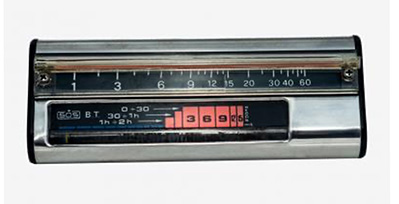 |
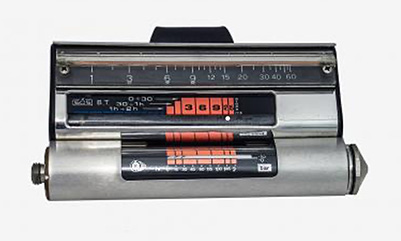 |
| fig. 8 - Il DCS | fig. 9 - Il DCS+Dt2 |
DCS/DT2 gauge was different not for its functioning components but for its coupling to an integrated analogycal pressure gauge, which showed air pressure in the tank, connected to the HP regulator port with a high pressure hose. Pressure gauge alerted diver of the minimum air needed to make indicated deco stops.
1980 - DCR GAUGE
Last born of decompression gauges, the DCR was also the more complete, mainly developed for professional divers. Shown values were the same of U.S. Navy decompression tables. This specific model was designed for repetitive dives and extraordinaly expositions, with decompression stops extended also to 18 and 21 meters, besides the standard 15 - 12 – 9 – 6 – 3 meters. Another big difference with the other models was that its surface interval time could have set from 2 to 24 hours..
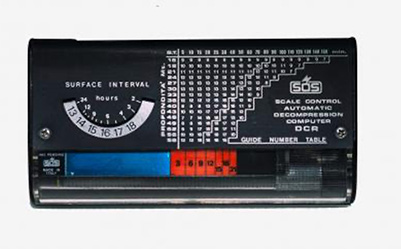 |
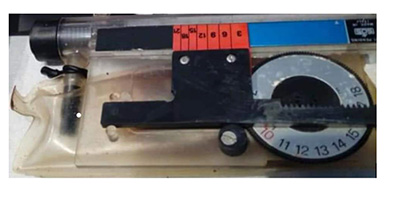 |
| fig. 10 - Il DCR | fig. 11 - il meccanismo interno del DCR |
1983 - TABEL TIMER
In 1983 Sos launched a brand new device, the Table Timer, developed for a depth up to 60 meters. Decompression table values did not have a numeric expression, but they were traced in a stripe winded up to some rolls which, depending on the different deco depths, showed color diagrams for the exit to the surface or deco stops.
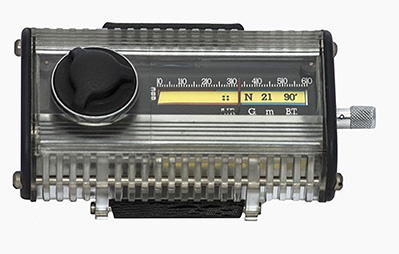 |
| fig. 12 |
Its functioning was very easy; it was enough enter the water and the timer automatically turned on which, at its turn, actioned the red color pointer along the chose ndiagram, thus showing the deco stop depth. Having also the function of dive plan, it was also mentioned in the stripe the quantity of air needed for each descend and the letter of the belonging group for repetitive dives.
________________________
DIVERS’ MISTAKES
The most popular SOS decompression gauge was, without any doubt, the DCP in its two versions in plastic and in stainless steel, inseparable companion of millions of dives all around the world for more than 2 decades. However, it was also the cause of several decompression accidents, luckily of small entity like a type 1 DCI with more or less severe joint pains, called “bends”. Moreover, sometimes – how many times in percentage is impossible to say – these accidents were not a direct cause of the instrument, but a consequence of the user’s negligence or “cunning trick”. Although very robust, for an unknown reason this instrument could lose its calibration, thus beginning to give wrong information. To check its integrity, in its use manual was indicated a simple test to make, periodically. The user had to lower the DPC underwater connected to a line and weighted, leave it at the exact depth of 30 meters for 30 precise minutes; than higher it quickly. In the surface, the needle had to be in the zone of the second red rectangle; if the result was different, the instrument had to be serviced. How many people could have remembered to make this test, at least at the beginning of the diving season? In fact, it could happen that in the lung there was a capillary hose caused by anything, with the consequence to lose some air as soon as the dive pressure was getting higher. A little bit today, a little bit tomorrow, at a certain time the lung started almost deflated and sooner, while in depth, it did not have enough air left to move the Bourdon tube and the index in the quadrant. While ascending, the diver followed the wrong data without knowing it.
A more serious error was the “cunning tricks”, not too much rare. When the DCP index was going to exit, let us assume, from the 6-meter sector direct to the reached one of 9 meters, it was sufficient a jump of a few meters towards the surface to “freeze” it in its position. Then, the diver could proceed his ascent without problems up to the indicated stop at 6 meters. However, without that jump the instrument would have signaled the stop at 9 meters, without considering that, ascending from the bottom too quickly it has always been the best way to incite micro bubbles. The sum of these two tricks could bring to consequences surely worse than a simple pain ………… and DCP was not the cause.
Luigi Fabbri
____________________
